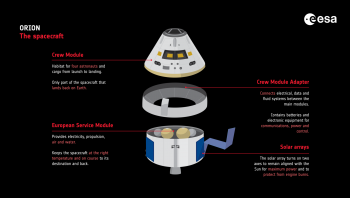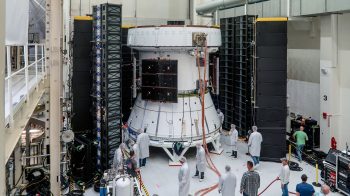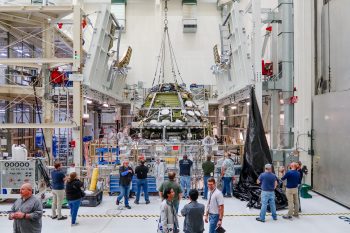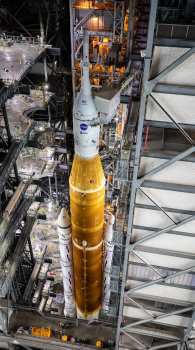The second European Service Module was connected to the rest of the Orion spacecraft which will be used in the Artemis II mission that will bring astronauts around the Moon and back for the first time in over 50 years.
The Orion spacecraft is composed of three main sections: the Crew Module, where the four astronauts will live, the European Service Module that provides electricity, propulsion, air and water and the Crew Module Adapter, which connects the two other sections.

The modules of the Orion vehicle.
Credit: ESA/K. Lochtenberg
After months of testing at NASA’s Kennedy Space Center in Florida, USA, the second European Service Module, or as we call it ESM-2, was connected to the rest of the Orion vehicle. The spacecraft will be used for the Artemis II mission, which will take astronauts around the Moon and back to Earth for the first time in over 50 years.
Let’s find out more from Marco Arcioni, who leads the Assembly Integration and Testing team for the European Service Module at ESA.
What has been happening to this European Service Module since its arrival in the US?
ESM-2 arrived at Kennedy Space Center over two years ago now, on 14 October 2021, and it has been very busy since then. One of the first things we did was to connect ESM-2 to the Crew Module Adapter to form the complete service module. Since then, the service module has had to go through many different tests to ensure all its equipment is functioning correctly, communicates correctly with each other, and will withstand the intense launch. The third component of the Orion vehicle, the Crew Module, was also tested in parallel during this time.
What are the most important tests?
To be cleared for spaceflight, every single part of the service module has to be tested, so all of the tests are important. But if I have to choose, the important tests have been the Thermal Cycle Test , which assesses how well the spacecraft will withstand extremes of temperature, and the Direct Field Acoustic Test which assesses how well the spacecraft will withstand the vibrations of launch.
The upcoming tests will also be very important. Now that the crew and service modules have joined as one, we can power up Orion and check whether all parts work together correctly. This is a crucial step in the process and allows the European and US teams to validate that all systems communicate with each other and that the guidance, navigation and control loops and mission closed-loops are functioning well together.

D-FAT testing at NASA’s Kennedy Space Center, 5 May 2023. Credits: NASA
How is the European Service Module connected to the rest of the Orion spacecraft?
The European Service Module is connected to the rest of the Orion spacecraft via the Crew Module Adapter, which itself connects to the Crew Module; this second connection between the Crew Module Adapter and the crew module happened a few days ago. Mechanically, the Crew Module Adapter and the Crew Module are connected by six separate points around the heat shield of the capsule, with data and power connections and pipes for fluids between the two section also going around the heat shield.

The cone-shaped crew module being stacked over the service module below it at Kennedy Space Center.
Credit: NASA
What are the next steps for the integrated Orion spacecraft until launch?
Now that the crew and service modules have been connected, the Orion spacecraft will be powered up for the first time. After that, we will continue to test Orion to check that the two modules are compatible as a single vehicle.
Next year will be very busy for Orion and the teams. The solar wings will be installed, after which the vehicle will move to the Exploration Ground Systems phase, where the tanks will be filled with propellant. From there, Orion will be connected to the launch abort system, and then with the mega Moon rocket, SLS, in preparation for the Artemis II launch.

SLS, the mega Moon rocket used for Artemis missions, seen inside the Vehicle Assembly Building before the launch of Artemis 1.
Credit: NASA/Glenn Benson
The European Service Module is part of ESA’s Terrae Novae exploration programme leading Europe’s human journey into the Solar system.

 Automated Transfer Vehicle page
Automated Transfer Vehicle page ATV blog archive
ATV blog archive
Discussion: no comments